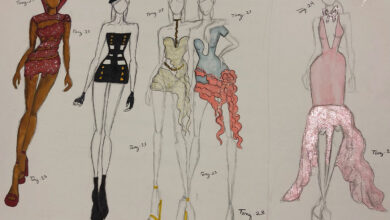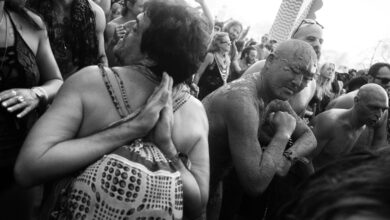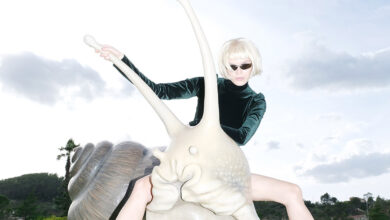Two exhibitions in Bucharest”s MNAR and MNAC celebrate the historical Gobelins tapestries, reintroducing them to their connoisseurs and to new art and design fans.
Text by Anna Battista

Located in Paris, the tapestry factory of the Manufacture des Gobelins supplied throughout the centuries the court of Louis XIV and of many other monarchs all over Europe.
The factory still produces tapestries for French governmental institutions and for contemporary artists and, to celebrate its art, two exhibitions were recently launched in Bucharest.

Entitled “Les Manufactures des Gobelins: quatre siècles de création”, the event is divided in two sections, one at the Muzeul Naţional de Artă al României (National Museum of Art of Romania – MNAR) and the other at the Muzeul Naţional de Artă Contemporană (Museum of Contemporary Art – MNAC), hosted in a wing of the People’s Palace, built in the 1980s by former communist dictator Nicolae Ceauşescu.
The former displays royal tapestries created between 1600 and 1800; the latter features instead contemporary pieces from 1950 until today.
The main aim of this double event is to show how the role of tapestry has changed throughout the centuries, turning from a form of art that reflected the splendours of the royal courts to a way for some of the greatest artists of the 20th century to convey their vision through new techniques, forms and styles.

Nothing has substantially changed at the factory: in the past an artist sketched the design, a painter turned it into an oil work the same size as the tapestry and then highly skilled craftspeople wove the tapestries using silk, wool, and sometimes gold or silver threads.
Today the painter retouches a cardboard model made increasing the proportions of a photographic model, but it still takes an entire day to weave a surface about the size of the human hand and one year to produce one square metre of tapestry.
The 20 tapestries on display at the MNAR – woven on the models of famous artists such as Simon Vouet, Charles Le Brun, Pierre Mignard and Carle Van Loo – were made in the 17th and 18th centuries to decorate the sumptuous residence of French kings. The main materials employed in these cases were wool and silk with gold and silver threads while the themes were mythological, biblical or historical.
Masterpieces such as “The Colossus of Rhodes”, “The Triumph of Alexander”, “Parnassus”, “L’Histoire du Roi” or “Triumph of Minerva” decorate the walls of the ground gallery with their colours and impressive trompe-l”oeil effects created by elaborate floral garlands, birds and picture-frame borders, showing the virtuosity of the craftspeople who made them.
As the decades passed a new brightness was added to the colours: in the 19th century, French chemist Michel Chevreul (1786-1889), the inventor of the colour circle, was hired by the factory to investigate the fading of their tapestry threads and discovered the effects created by simultaneous contrasts between adjacent coloured threads.
Colours started to constantly enrich the Gobelins tapestries becoming the main protagonists of the second part of the exhibition on display at the MNAC.
Here, in a spacious gallery on the second floor, contemporary tapestry reveals itself in all its glory, showing how, through a completely new approach, an old technique can create innovative effects while staying true to itself.
Designed by architects, painters and sculptors, the 35 tapestries (some of them by the Manufacture des Beauvais) included in this section curated by Marie-Hélène Massé-Bersani, display a wide range of forms and styles: from Op and Kinetic Art with Victor Vasarely and Alexander Calder to hyperrealism with Gérard Schlosser’s photographic montage on tapestry, to figurative artists like Erró and Eduardo Arroyo.

Henri Matisse’s “Polynésie: Le Ciel”, inspired by his trip to Tahiti and based on different shades of blues forming the best online casino background for stylised birds and aquatic plants, instills in the visitor a sense of calm; Joan Miró’s “Femme au miroir”, evokes instead a delirious yet playful world; Picasso’s “Femmes à leur toilette” perfectly shows the technical challenge behind contemporary tapestry with its tones of colours, textures and patterns swiftly changing from one figure to the next, while architect Le Corbusier, who started getting interested in tapestry in 1936, created a modern mural using basic shades and geometric lines.

Harmony and dissonance characterise Sonia Delaunay’s vibrantly graphic “Composition N. 2” that contrasts with “Estampille” by Romanian-born sculptor Etienne Hajdu who focused on the importance of the absence of colours.


Outbursts of fiery shades merge and combine in Yves Oppenheim’s piece that calls to mind the chaos and ebullience of urban graffiti; Antonio Ségui’s “El sol no sale para todos” seems instead to focus on the theatricality of cartoons while Philippe Cognée’s city landscape with cars has a special magic, producing the illusion you’re staring at a painting rather than at a tapestry, thanks to the clever use of different thicknesses of wool employed to perfectly reproduce he brush strokes.

These artworks aren”t exhibited that often because it is hard to find an adequate space as some of them are huge. Yet Jean Dewasne’s “Coeur Cinabre” with its colourful polygons, probably the largest piece of tapestry in the world, managed to find a perfect place in the second room of the MNAC gallery, next to Serge Poliakoff’s vertical composition “Forme”, Emile Gilioli’s abstract tapestry “Jeunesse”, the rigorous geometric planes of Alberto Magnelli’s “Nature Satellique” and Yaacov Agam’s vivid “Petit secret”, with its bright combinations of colours creating unique effects.


Initially produced by French, Italian and Flemish artists, tapestry radically transformed itself, turning from an archaic technique into a modern form of art. The Gobelins manufacture developed century after century, combining heritage with artistic creation, conceiving imaginary worlds through vibrantly kaleidoscopic threads and finally sparking up an innovative dialogue between the artist and the artisan
“Les Manufactures des Gobelins: quatre siècles de création” is at the Muzeul Naţional de Artă al României and at the Muzeul Naţional de Artă Contemporană, Bucharest, Romania, until 26th February 2012.

Anna Battista research trip to Romania was made possible through a journalistic grant from the Institutul Cultural Român (ICR – Romanian Cultural Institute), Bucharest.









